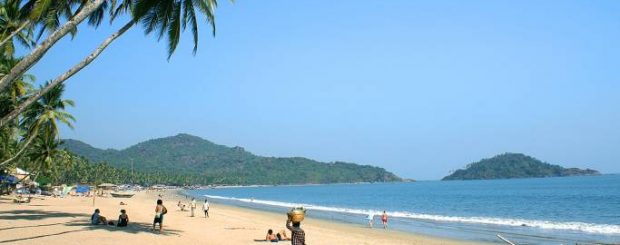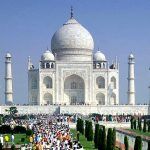Golden Triangle with Goa Tour Package
Day 1: Arrive Delhi
Arrive Delhi. Meeting and assistance on arrival at International airport & transfer to hotel.
Delhi: India’s capital and major gateway to the country, contemporary Delhi is bustling metropolis, which successfully combines in its fold the ancient and the modern. Its Strategic location was one of the prime reasons why successive dynasties chose it as their seat of power. It is not surprising then that what constitutes Delhi today is a conglomerate of seven cities. Down the ages the region in and around modern Delhi saw Lalkot built in the mid-11th century, Siri established by Allauddin Khilji, Tughlakabad, and Ferozabad built by the Tughlaks followed by the city of the Lodis and then came Shahjahanabad, capital of the Mughals under Shah Jahan.
New Delhi reflects the legacy the British left behind, distinction between the capitals of the British and the Mughals respectively. But wherever the visitor goes he will invariably confront the city’s past.
The throbbing present of Delhi pulls one out of reflections on a mute past. The divisions in the walled city and New Delhi also mark the varied lifestyles. The walled city is all traditions, where as New Delhi in contrast, is a city living up to contemporary international standards. Delhi also serves as the major gateway for touring the internationally known tourism destinations of Agra and Jaipur.
Possibility to Organize:
A Traditional Indian Welcome at the hotel.
Day 2: Delhi
Morning sightseeing of New Delhi is consisting of drive through the Raisina Hills- Parliament House, India Gate, President House; 16th century tomb of Emperor Humayun built of Marble & Red stone in typical Mughal fashion, Lotus temple (Bahai Temple) & Qutab Minar. Afternoon sight seeing of Old Delhi is highlighted Shah Jahan’s Red Fort, the bustling market place of Chandni Chowk by Rickshaw Puller Ride, Raj Ghat, and the cremation site of Mahatma Gandhi.
Possibility to Organize:
A Village Fair Theme dinner.
A Mock Wedding Theme.
Day 3: Delhi – Agra (By Surface)
Morning drive to Agra, the city of the Taj and on arrival, check in at the hotel.
Agra, Agra is globally renowned as the city of the Taj Mahal. But this royal Mughal city has, in addition to the legendary Taj, many monuments that epitomize the high point of Mughal architecture. In the Mughal period, in the 16th and 17th centuries, Agra was the capital of India. It was here that the founder of the dynasty, Babar, laid out the first formal Persian garden on the banks of the river Yamuna. Here, Akbar, his grandson raised the towering ramparts of the great Red Fort. Within its walls, Jahangir built rose-red palaces, courts and gardens, and Shahajahan embellished it with marble mosques, palaces and pavilions of gem-inlaid white marble.
The crowning glory of the city is obviously the Taj, a monument of love and imagination that represents India to the world.
Afternoon city tour of Agra visiting the world famous Taj Mahal, Agra Fort & Itmad-ud-Daulah.
Taj Mahal – stands serene and awesome, on a raised marble platform, by the banks of the Yamuna, testifying to the timelessness of art and love. Its pure white marble shimmers silver in the soft moonlight, exudes a shell – pink glow at dawn, and at the close of the day, takes on the tawny, fiery hue of the majestic sun. Shahjahan built the monument in memory of his beloved wife, Mumtaz Mahal, the ‘lady of the Taj’, who died giving birth to their 14th child. It has been called the most extravagant monument ever built for the sake of love.
Agra Fort- Among the other monuments that Agra takes pride in, built by three of the greatest Mughal emperors. The construction of this massive structure began in 1565, under Akbar, and continued till the time of his grandson, Shahjahan. The Diwan – i – Am, the Diwan – i – Khas, the Khas Mahal, the Palace of Mirrors, the Pearl mosque, the Nagina Masjid, the Garden of Grapes, and the Fish Pavilion are the other monuments in the fort complex.
Itmad-ud-Daulah tomb- stands in the centre of a grand Persian garden, an architectural gem of its times. It is the tomb of Mirza Ghiyas Beg, Emperor Jehangir’s wazir, or Chief Minister, and also his father – in- law. This splendid garden tomb is believed to be the precursor of the magnificent Taj Mahal, and was the first Mughal structure to be built entirely of marble, and the first, again, to make use of pietra dura, the inlay marble work that came to be typical of the Taj.
Possibility to Organize:
A Mughal Theme Dinner.
A Mock Wedding Theme.
Day 4: Agra – Fatehpur Sikri – Jaipur (By Surface)
Morning drive to Jaipur en route visiting Fatehpur Sikri.
Fatehpur Sikri was the capital of the Mughal Empire from 1571 to 1585, during the reign of Emperor Akbar. The city was built around the abode of Sheik Salim Chishti, a mystic who had advised the childless Emperor Akbar and shortly after his first son was born. Fatehpur Sikri was a glorious city with its beautiful architecture, constructed entirely of red sandstone, but it was built in an area that had a low water supply. For this reason, the city was abandoned shortly after the death of Emperor Akbar.
The palace buildings and mosque that is still in use are well-preserved even after 400 years. Although Fatehpur Sikri is a ghost city there is much to see and many visitors take a day trip from Agra.
The palace complex of Fatehpur Sikri includes the Palace of Jodhabai, named for Akbar’s Hindu wife; the Sunahra Mahal, home of Akbar’s Christian wife; Birbal’s House, said to be the home of Akbar’s two senior wives; and the Panchal Mahal, a five storey pavilion used by the ladies to watch the court. Fatehpur Sikri is at its most peaceful at sunrise and most lovely at sunset.
Jaipur, the vibrant capital of Rajasthan is popularly known as the pink city because of the pink colored buildings in its old city. It sits on a dry lakebed in a somewhat arid landscape, surrounded by barren hills surmounted by forts and crenellated walls. This buzzing metropolis is certainly a place of wild contrasts and a feast for the eyes. Vegetable laden camel carts thread their way through streets jam packed with cars, rickshaws, bicycles and pedestrians frantically dodging the crazy traffic. Traditionally dressed Rajput men sporting bright turbans and swashbuckling moustaches discuss village politics outside restaurants serving spaghetti and American ice cream sodas. Jaipur has long outstripped the confines of its city walls and is today amongst the most tumultuous and polluted places in Rajasthan. Despite this, it seldom disappoints first time visitors.
On arrival in Jaipur, check in at the hotel.
Possibility to Organize:
A Traditional Maharaja Welcome at the hotel.
Day 5: In Jaipur
Morning excursion to Amber Fort including an Elephant ride. Afternoon city tour visiting City Palace, Observatory (Jantar Mantar), Hawa Mahal (Palace of Winds), Jaigarh, Nahargarh Forts.
Possibility to Organize:
A Gala Rajasthani evening.
A Special Dinner at the Samode Palace in Samode.
A Special Dinner at the Maharaja’s City Palace in Jaipur.
Day 6: Jaipur – Mumbai – Goa by flight
Morning transfer to the airport for flight to Goa via Mumbai. On arrival, transfer to the hotel.
Goa, The 131 km long coastline is set on the golden Konkan coast, on the Western Ghats, along the Arabian Sea. This small former Portuguese enclave is one of India’s most dazzling tourist mosaics. Goa deserves every bit of the sobriquet ‘The Pearl of the East’. The name Goa is derived from the Konkani word ‘Goyan’, which means a patch of tall grass.
Panaji, Goa’s capital Panaji has some fine beaches. To the north of Panaji, lie two of Goa’s most popular beaches – Calangute and Baga. These two beaches together stretch for more than 7 km. Stroll along in the morning, as the brilliant rays of the rising sun fall upon the sea, and you wouldn’t know the difference between the sea and the sands. Watch fishermen taking in the morning’s catch.
Sinquerim, it is one of the best beaches in Goa with international class facilities for water-skiing, para-sailing, fishing, scuba-diving and wind-surfing.
Calangute, it is, undoubtedly, the most popular beach in Goa. You can stay here in any one of the many resorts and hotels that dot the beach, or you can spend your vacation with one of the families, which own houses near the beach.
Day 7: In Goa
Morning city tour of Goa. Afternoon relax on the beach.
Possibility to Organize:
A Goan Carnival Theme Dinner.
A seafood barbecue on the beach.
A Kunbi Fishing Village Theme Dinner.
Day 8: In Goa
Day at leisure to relax at the beach.
Day 9: Goa – Mumbai by flight
Morning at leisure. Later, transfer from hotel to the airport to connect flight to Mumbai. On arrival, transfer to International airport to connect flight for onward destination or stay overnight at the hotel for travel the next day.
Day 10: Departure Mumbai
In time transfer from hotel to International airport to connect flight for onward destination.
Golden Triangle with Goa Tour, Golden Triangle Tour with Goa, Golden Triangle with Goa Tour Package, Goa Beaches Tour, Delhi Agra Jaipur Goa Tour, Goa tour in India, goa india, goa holiday, beaches in goa
Social Share
Golden Triangle Tours
Golden Triangle with Wildlife Tour
Golden Triangle Tour
Yoga Meditation Tour with Golden Triangle
Golden Triangle Tour by Rail
Golden Triangle Tour
Contact Us
Prish India Tours
(A unit of Prish Tours Pvt. Ltd.)
139, First Floor, Vardhman Crown Mall, Plot No. 2, Sector 19, Dwarka, New Delhi – 110075, (India).
+91 11 4166 1466
+91 98104 07877, 98109 30054






